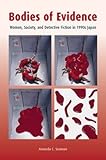Bodies of Evidence : Women, Society, and Detective Fiction in 1990s Japan / Amanda C. Seaman.
Material type: TextPublisher: Honolulu : University of Hawaii Press, [2004]Copyright date: ©2004Description: 1 online resource (206 p.) : illusContent type:
TextPublisher: Honolulu : University of Hawaii Press, [2004]Copyright date: ©2004Description: 1 online resource (206 p.) : illusContent type: - 9780824827366
- 9780824861667
- 820
- online - DeGruyter
- Issued also in print.
| Item type | Current library | Call number | URL | Status | Notes | Barcode | |
|---|---|---|---|---|---|---|---|
 eBook
eBook
|
Biblioteca "Angelicum" Pont. Univ. S.Tommaso d'Aquino Nuvola online | online - DeGruyter (Browse shelf(Opens below)) | Online access | Not for loan (Accesso limitato) | Accesso per gli utenti autorizzati / Access for authorized users | (dgr)9780824861667 |
Browsing Biblioteca "Angelicum" Pont. Univ. S.Tommaso d'Aquino shelves, Shelving location: Nuvola online Close shelf browser (Hides shelf browser)
Frontmatter -- Contents -- Acknowledgments -- CHAPTER 1. Introduction -- CHAPTER 2 .A Home of One's Own Identity, Community, and Nostalgia in Miyabe Miyuki's All She Was Worth -- CHAPTER 3. Office(r) Ladies Police Work as Women's Work -- CHAPTER 4. Sex and Violence Is That a Gun in Your Pocket, or Are You Just Happy to See Me? -- CHAPTER 5. Sexing the City Bodies and Space in the Work of Matsuo Yumi -- Afterword -- Notes -- Bibliography -- Index
restricted access online access with authorization star
http://purl.org/coar/access_right/c_16ec
The publication in 1992 of Miyabe Miyuke's highly anticipated Kasha (translated into English as All She Was Worth) represents a watershed in the history of Japanese women's detective fiction. Inspired by Miyabe's success and the increasing number of Western mysteries in translation, women began writing mysteries of all types, employing the narrative and conceptual resources of the detective genre to depict and critique contemporary Japanese society-and the situation of women in it. Bodies of Evidence examines this recent boom and the ways in which five contemporary authors (Miyabe, Nonami Asa, Shibata Yoshiki, Kirino Natsuo, and Matsuo Yumi) critically engage with a variety of social issues and concerns: consumerism and the crisis of identity, discrimination and harassment in the workplace, sexual harassment and sexual violence, and motherhood. Bodies of Evidence moves beyond the borders of detective fiction scholarship by exploring the worlds constructed by these authors in their novels and showing how they intersect with other political, cultural, and economic discourses and with the lived experiences of contemporary Japanese women.
Issued also in print.
Mode of access: Internet via World Wide Web.
In English.
Description based on online resource; title from PDF title page (publisher's Web site, viewed 02. Mrz 2022)









